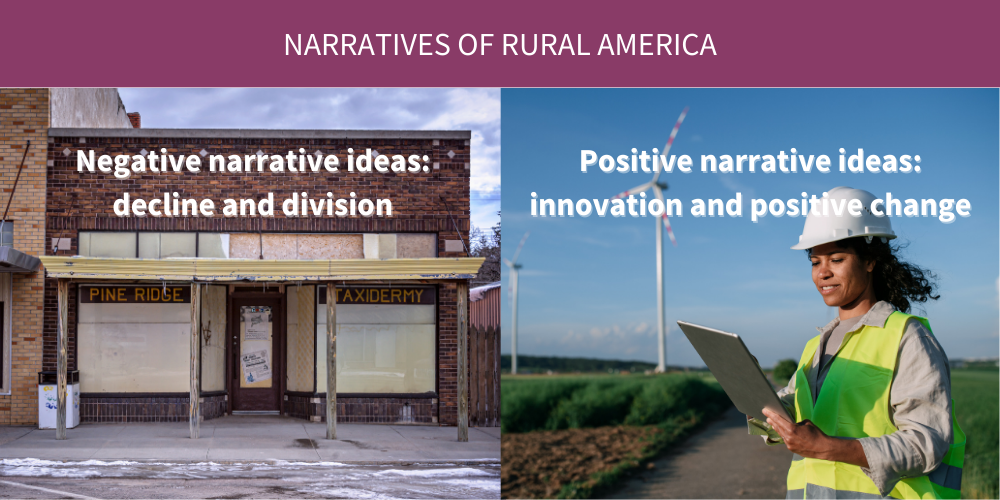The prevailing cultural narrative of rural America is one of “decline and division,” writes Brookings Institute Senior Fellow Tony Pipa on the homepage of his podcast Reimagine Rural. Cultural narratives like this matter because they shape our identities and our perceptions of the world—and consequently our behaviors and decisions.
Tony sees rural America differently. After decades of research and policy work, he’s trying a new strategy to share what he sees: a podcast. He visits rural communities and talks with locals to show rural places characterized by innovation, community leadership, and positive change. The podcast seeks to challenge the prevailing negative narrative and influence policymakers to invest in a new narrative of rural prosperity.
To Change Narratives, Tell Strategic Stories
Challenging these narratives requires confronting them head-on with new narratives that are equally clear and meaningful. These new narratives offer a lens for interpreting events and circumstances differently; they’re the new ideas that people take away from their experiences and the stories they hear.

Strategic Storytelling brings the new narrative to life. Starting with the overarching narrative ensures that stories are seen as real examples of a larger reality, not just anecdotes.
Storytelling Lessons from Reimagine Rural
In the Reimagine Rural podcast, Tony presents a new narrative of rural places and people that focuses on exciting opportunities, creative potential, and economic growth. He visits a diverse set of towns across the country to tell stories that showcase the narrative in action and paint a realistic and compelling picture for listeners. At Hattaway, we call this Strategic Storytelling—telling stories framed by a narrative, featuring real people in real situations, told in a way that’s easy to understand—and we have found that it can change people’s attitudes in impactful ways.
Speaking to a communications community of practice focused on rural narrative change, Tony shared three best practices for challenging negative cultural narratives through storytelling:

Rely on real people telling their own stories. Storytelling research has found that firsthand accounts—in which readers or listeners hear people tell their own stories—can bridge differences between groups of people.
“Given where the discourse is around rural America and the rural–urban divide, the podcast is a way to really humanize what is actually happening,” said Tony. He told us about speaking with John Brown, former mayor of Shamokin, Pennsylvania, who is a Republican. “When you hear how dedicated he is to his community, and how important public investment is to him, it’s no longer red versus blue. It’s a person trying to figure out how to make it work in his local town.”
Lifting up the voices of local people also captures the realities and complexities that challenge inaccurate and simplistic stereotypes of people and places. “It’s really hard to capture community identity and dignity in a policy analysis,” Tony reflected. His podcast forefronts personal stories and then connects the stories to policy.
Be strategic in gathering stories. Storytelling in support of a new Narrative Frame requires strategic decisions to be effective. Reimagine Rural aims to shift the rural narrative nationwide, so the podcast features towns across the country that show the narrative through different stories that advance the same positive narrative ideas. Tony can’t go everywhere or speak to everyone, so he also reaches out to local organizations to help him make these decisions.
When deciding whose stories to include in an episode, Tony strives to be “balanced and representative” of reality. “I always speak to one elected leader and one outside organization who knows the town well, even if they’re not included in the episode,” said Tony. “And then I try to get a set of individual perspectives that gives an authentic view of the town.”
Tony considers politics when deciding where to go. He said, “Some states are politically important to include on the podcast because of the people there and their political positions. We have an episode on Pennsylvania, and a representative from Pennsylvania is chairing the House Agriculture Committee. We have an episode on Arkansas, and that senator is the ranking member of the Agriculture Committee.”
Use vivid language for storytelling. Stories can move people to act, from swaying votes and shaping policy to directing resources to a local cause or community. Research shows that it’s easier to understand things we can picture, and we’re more likely to work toward goals we can visualize. Language that evokes images of people, places, things, and actions is more likely to move people to action.
Tony explained that for international policy, Congressional members may travel overseas to better understand a policy’s impact; he said Reimagine Rural “is a way for policymakers to ‘travel’ to rural areas across the nation and has them experience firsthand, in audio format, stories that might be different from their own districts.” By using vivid language, Tony paints the picture of narrative change to influence policymakers to action.
Reimagine Rural aired a final, reflective episode in late March 2023, but as the new positive rural narrative spread, listeners prompted an additional episode by reaching out to share their own stories—they believed in the new narrative, they saw themselves in it, and they support this narrative change in action.
Learn more about narrative change in our American Aspirations handbook.
Do you need to change a negative narrative? We’re happy to help. Reach us at info@hattaway.com.



.png)